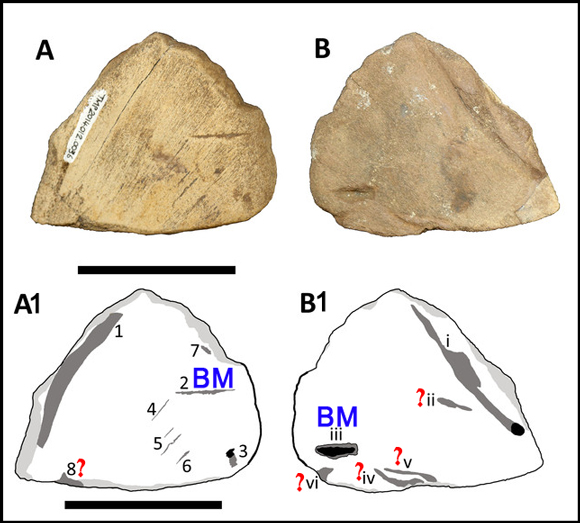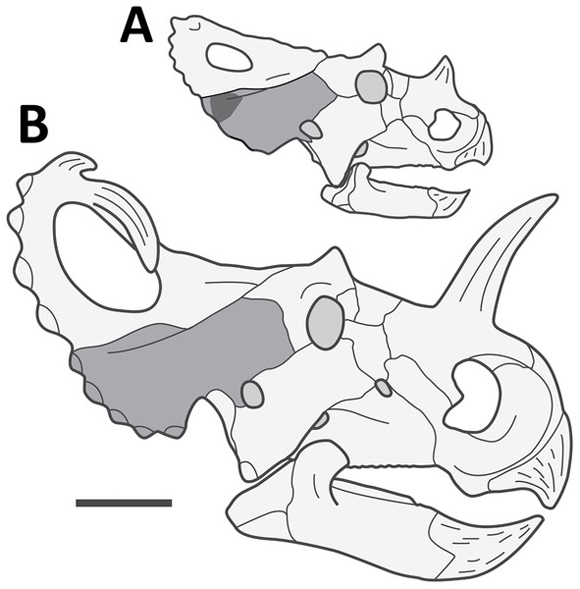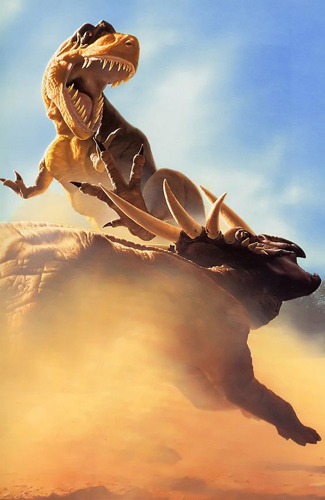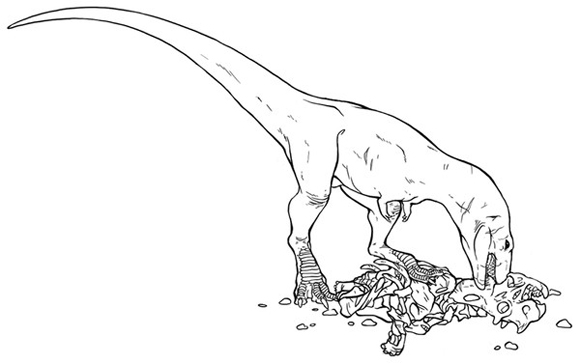Feeding Traces on the Frill of a Young Centrosaurus
Bite Marks Found on the Frill of a Young Centrosaurus
The movies and television documentaries featuring dinosaurs are stuffed full of them, but the fossil record tells a different story. What are we referring to? Dinosaurs hunting, attacking and fighting other dinosaurs. Rarely has a programme or film been produced about the Dinosauria that does not feature some gory scenes of a bloody battle or a fearsome theropod feasting on some poor, unfortunate plant-eating victim. However, although such interactions obviously took place, the fossil record demonstrating such behaviour is extremely sparse. A new paper, published in the open access journal “PeerJ”, reports on the discovery of bite marks preserved on the frill of a young Centrosaurus.
This raises two intriguing questions:
- Which meat-eating dinosaur made the bite marks?
- Is this evidence of predation or scavenging a carcass?
Dinosaurs Fighting – A Tyrannosaur Attacks a Horned Dinosaur (Styracosaurus)
Picture credit: John Gurche
Bite Marks – Tell-Tale Signs of Predator/Prey Interaction
Bite marks on fossil bones can provide valuable information about interactions between carnivorous dinosaurs and the animals that they attacked. It is not always possible to distinguish whether the trace fossils represent wounds inflicted on an animal during a fight, or whether these marks represent post-mortem feeding, such as consumption of the victim. If there are signs of healing and bone growth, palaeontologists can be confident that the bite marks in that instance represent a lucky escape for the intended victim.
The key thing to note, is that the more data about bite marks that can be collected, the better the dataset that palaeontologists have to compare potential bite mark injuries against.
Part of the Skull of a Juvenile Centrosaurus With Tooth-marks
Ironically, quite a large proportion of the tooth-mark fossils associated with dinosaurs come from those deposits that are associated with the remains of large-bodied tyrannosaurids. In this newly published paper, the scientists from Queen Mary University London and the Royal Tyrrell Museum (Alberta, Canada), report on the discovery of a portion of the skull from a juvenile horned dinosaur. The bone, a fragment of the squamosal, which makes up part of the frill, was found on the surface of a dinosaur bonebed in the Dinosaur Provincial Park Formation. The fossil is approximately 76.3 to 75.6 million years old and has been assigned to the horned dinosaur species Centrosaurus apertus.
Views of the Fragment of the Squamosal Bone (Centrosaurus apertus) and Line Drawings

Picture credit: PeerJ with additional annotation by Everything Dinosaur
Key
BM = Probable bite marks
? = Possible bite marks
Feeding on a Young Centrosaurus
Analysis of the fossil found numerous marks and gouges on both sides of the fossil bone. Some of these marks could have resulted from damage due to transportation prior to burial. Other marks could reflect effects caused by chemical erosion or the presence of vascular grooves. However, the scientists were able to propose that at least some of the marks were due to teeth coming into contact with the bone.
The Position of the Partial Squamosal on the Skull of a Juvenile Centrosaurus and an Adult Skull Shown for Comparison

Picture credit: PeerJ
Although it is difficult to assess the size of the horned dinosaur based on such a small fragment of bone, the scientists suggest that based on comparisons with squamosal bones from adults, the juvenile Centrosaurus was perhaps about a third the size of a fully grown Centrosaurus.
Which Dinosaur Made the Feeding Traces?
The researchers ruled out crocodiles, other reptiles and mammals when it came to identifying what creature made the bite marks. This left the team with three types of theropod dinosaur to investigate. troodontids, dromaeosaurs and tyrannosaurs are known from the Dinosaur Provincial Park Formation. There is also the genus Richardoestesia to consider, its affinity within the Theropoda is uncertain. The bite marks are too small to have been made by a large tyrannosaur, but a juvenile tyrannosaur might have scavenged the carcass.
It is also possible that a dromaeosaurid may have fed on the remains as well. It is possible that both the dromaeosaurid and a young tyrannosaur fed on the carcass, after all, modern carcasses may be fed on by multiple species (lions may kill a zebra but hyenas may chase them off the kill and rob them of the carcass – kleptoparasitism).
To read an article from Everything Dinosaur published in 2015 that looks at the structure of the teeth of different Theropod dinosaurs: Research to get your Teeth Into.
A Hypothesised Reconstruction of a Juvenile Gorgosaurus Feeding on the Carcass of a Juvenile Centrosaurus
Picture credit: Marie-Hélène Trudel-Aubry/PeerJ
Slim Pickings
The marks on the squamosal fragment represent the first documented case of a carnivore consuming a juvenile ceratopsid, but the trace fossils may represent scavenging a corpse rather than predation. However, there is not a lot of meat on a squamosal bone. The scientists suggest that the feeding marks represent late stage consumption, as the most nutritious parts of the young Centrosaurus had already been eaten. It is possible that a large tyrannosaur made the kill, fed and then abandoned the carcase which was later picked over by other theropods.
Despite the apparent preferences for feeding on juvenile dinosaurs, most feeding traces described to date are on the bones of adults which may have resisted being consumed and destroyed (even by large tyrannosaurs). Feeding traces on a juvenile dinosaur remain unusual and exceptionally rare. Perhaps the size and shape of ceratopsian skulls, even in juveniles, made them difficult to process or required an excess of handling effort for a relatively little reward in terms of food.
The scientific paper: “Bite Marks on the Frill of a Juvenile Centrosaurus from the Late Cretaceous Dinosaur Provincial Park Formation, Alberta, Canada” by David W.E. Hone, Darren H. Tanke and Caleb M. Brown published in PeerJ.
Visit the Everything Dinosaur website: Everything Dinosaur.



